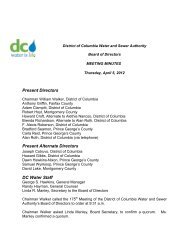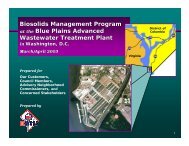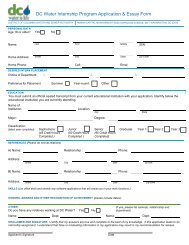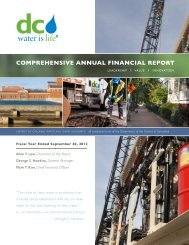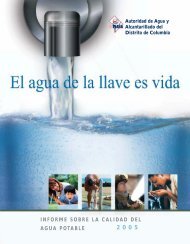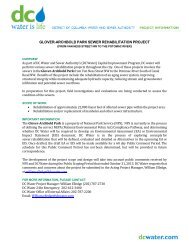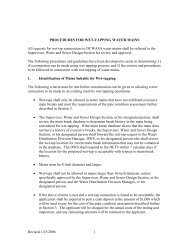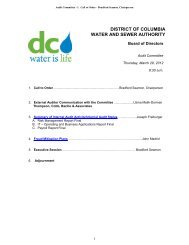FY 2020 Capital Improvement Program - DC Water
FY 2020 Capital Improvement Program - DC Water
FY 2020 Capital Improvement Program - DC Water
Create successful ePaper yourself
Turn your PDF publications into a flip-book with our unique Google optimized e-Paper software.
materials such as brick and concrete, vitrified clay, reinforced concrete, ductile iron, plastic, steel, brick, cast iron, cast in place<br />
concrete, and even fiberglass.<br />
During <strong>FY</strong> 2009, <strong>DC</strong> <strong>Water</strong> completed a Sewer System Assessment and the <strong>Water</strong> Facility Plan (“Study”). This document culminated<br />
a five year effort involving sewer inspection and condition assessment, development of a sewer GIS and database, hydraulic<br />
monitoring and modeling to assess system capacity and the development of prioritized activities for system improvement. This Study<br />
identified a significant increase in funding needed for specific sewer infrastructure improvements. As recommended by the Study,<br />
the current CIP includes funds for an ongoing, annual sewer inspection program, which may identify the need for additional work.<br />
Key Findings of the 2009 Sewer Facilities Plan:<br />
Generally speaking, major sewer pipe infrastructure can meet current and future population needs; however, continued<br />
investment in upgrades to major infrastructure elements is needed.<br />
88% of the sewers inspected had some defects, 60% of which could be addressed using localized repair and the remaining<br />
require, mainly, lining.<br />
94% of the manholes inspected were found to have one or more defects<br />
The number and severity of pipe defects indicates an expected increase in problems in pipes greater than 75 years old.<br />
Older pipes can be in good condition (and younger ones can be in poor condition), but at the 75 year mark, <strong>DC</strong> <strong>Water</strong> can<br />
assume that more extensive and frequent inspection is needed.<br />
There are approximately 210 miles of sewers in stream valleys and about 12.3 miles of these sewers were found to need<br />
some type of repair.<br />
There are about 316,000 linear feet of sewers with some portion under buildings; of those inspected, a preliminary list has<br />
been developed, and approximately 7,000 linear feet of sewers have been found to have multiple and/or significant defects,<br />
warranting rehabilitation or replacement.<br />
Key Recommendation of 2009 Sewer Facilities Plan- continue a two-pronged, parallel approach to the CIP program:<br />
Implement identified projects resulting from ongoing system condition and needs assessment, and an increase in the<br />
continued annual sewer pipe renewal program.<br />
Based on a 20-year planning outlook, this will require a $1.2 billion increase (2008 dollars) in capital spending to address<br />
currently identified projects ($536 million) and a sewer pipe renewal program ($664 million).<br />
The lifetime budget in this area has increased by $20 million from last years estimate and the proposed 10-year CIP has also been<br />
increased by just over $22 million as a result of the adding of <strong>FY</strong> <strong>2020</strong> and the dropping of <strong>FY</strong> 2010. Both of these amounts are<br />
expected to continue to increase in future years to reflect the ramping-up of this program through <strong>FY</strong> 2015 as recommended in the<br />
II - 6



